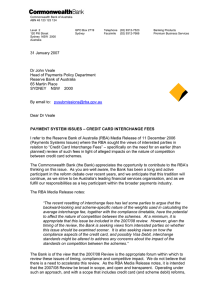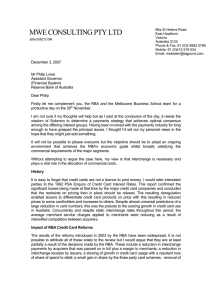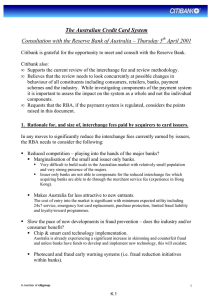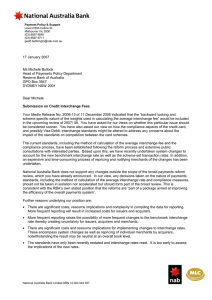30 April 2015 Dr Tony Richards Head of Payments Policy Department
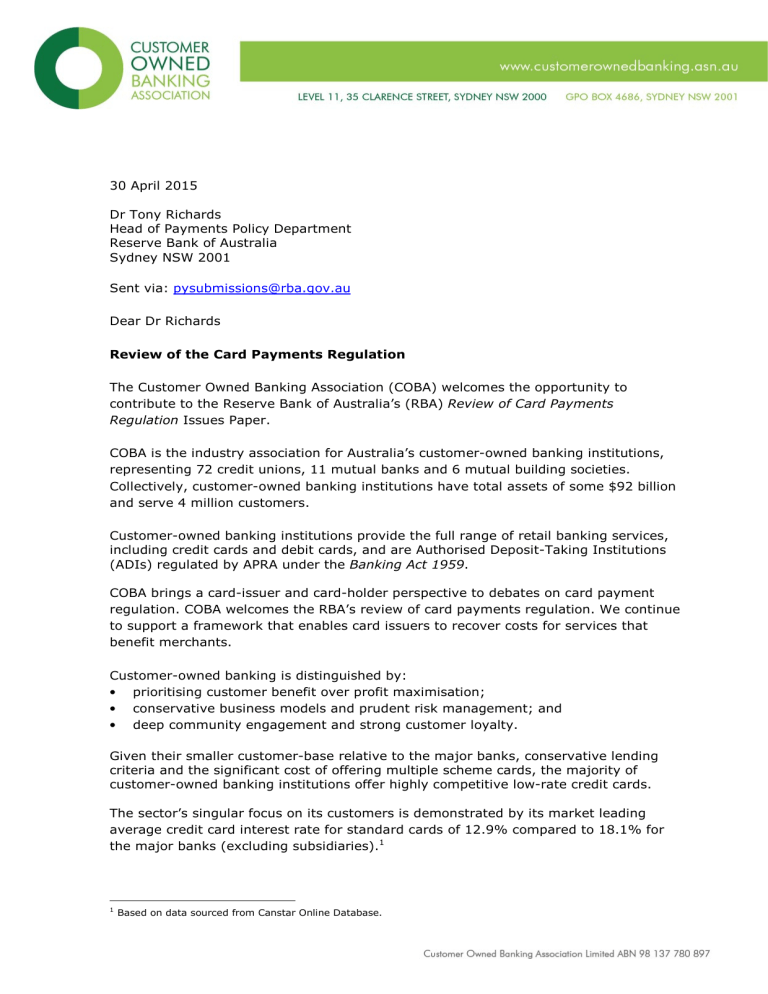
30 April 2015
Dr Tony Richards
Head of Payments Policy Department
Reserve Bank of Australia
Sydney NSW 2001
Sent via: pysubmissions@rba.gov.au
Dear Dr Richards
Review of the Card Payments Regulation
The Customer Owned Banking Association (COBA) welcomes the opportunity to contribute to the Reserve Bank of Australia’s (RBA) Review of Card Payments
Regulation Issues Paper.
COBA is the industry association for Australia’s customer-owned banking institutions, representing 72 credit unions, 11 mutual banks and 6 mutual building societies.
Collectively, customer-owned banking institutions have total assets of some $92 billion and serve 4 million customers.
Customer-owned banking institutions provide the full range of retail banking services, including credit cards and debit cards, and are Authorised Deposit-Taking Institutions
(ADIs) regulated by APRA under the Banking Act 1959 .
COBA brings a card-issuer and card-holder perspective to debates on card payment regulation. COBA welcomes the RBA’s review of card payments regulation. We continue to support a framework that enables card issuers to recover costs for services that benefit merchants.
Customer-owned banking is distinguished by:
• prioritising customer benefit over profit maximisation;
• conservative business models and prudent risk management; and
• deep community engagement and strong customer loyalty.
Given their smaller customer-base relative to the major banks, conservative lending criteria and the significant cost of offering multiple scheme cards, the majority of customer-owned banking institutions offer highly competitive low-rate credit cards.
The sector’s singular focus on its customers is demonstrated by its market leading average credit card interest rate for standard cards of 12.9% compared to 18.1% for the major banks (excluding subsidiaries).
1
1
Based on data sourced from Canstar Online Database.
The Canstar Online Database also shows that of the 193 personal credit cards subject to analysis, and excluding bonus or introductory rates, 19 of the 20 lowest rate personal credit cards on the market are offered by customer-owned banking institutions.
2
Case for regulatory reform?
COBA notes the RBA’s observation that “Australia now has a relatively low cost payments system by international standards.”
However, there appears to be a case for some modest amendments to the regulatory framework to address the negative impact on small merchants of some interchange fee trends. There is also a case for some further adjustment of the surcharging framework.
Any changes should be limited, with due consideration to avoid complexity, unnecessary cost, unintended consequences, confusion for consumers, and higher costs for issuers of low-cost, low-rate credit cards and their customers.
Recommendations
COBA supports further consideration of the following proposals:
• the weighted average interchange benchmark be retained but subject to annual review;
• a cap on the highest individual interchange fee rate that a scheme could offer, as well as a possible limit on the number of categories of interchange fees;
• prepaid cards be formally included within the Standard on interchange fees in the
Visa Debit system; and
• modify the RBA’s surcharging Standard to allow it to cap any surcharges that are not percentage-based at some low fixed-dollar amount.
Significant trends
COBA notes the following significant trends outlined in the RBA’s Issues Paper on premium cards, interchange fees and merchant service fees.
“Credit cards are more widely held by higher income individuals, with those in the highest income quartile far more likely to hold a premium-status card than those in the lowest quartile.” Customer-owned banking institutions serve a number of niche communities, including regional areas and particular industries or occupations (e.g. teachers, police and defence personnel) and the wider Australian community. While some of COBA’s larger members offer premium cards, generally, the customer base of customer-owned banking institutions is not the target market for super premium cards.
Given the majority of the customer owned banking sector issue ‘standard’ credit cards,
COBA is concerned to ensure any reforms that may be considered must be targeted at the growth in premium and super premium cards and do not have unintended impacts on our member ADIs and their customers.
The RBA raises concerns that “merchants are hindered in their ability to control their payment costs, given that they are typically unable to see the cost of different cards, are restricted by card scheme rules from choosing to accept only some types of debit or credit cards, and in practice are unable to differentially surcharge to reflect the difference in payment costs.” The RBA concludes that because of these factors,
“cardholders may not face the correct price signals associated with their choices, which
2
Ibid, 29 April 2015.
2
is likely to result in cross-subsidisation and less pressure to reduce the cost of payments.”
However, lowering the overall level of interchange fees would not address the issues facing merchants.
The RBA notes:
“There is a hierarchy of categories, which determines how the merchant, card and transaction categories interact. Typically, the relatively low ‘strategic’ interchange rates for large merchants have precedence over the interchange category for the type of card, so that the same relatively low rate for strategic merchants applies for all their transactions, including for those using premium cards with high interchange rates. However, merchants that do not have access to strategic or merchant-specific rates will face different rates based on the type of card presented.
“Based on the hierarchy of interchange rates, the cost of the high interchange rates for consumer premium and commercial cards falls entirely on small merchants and other merchants that do not benefit from special rates.”
“There are two significant consequences of these developments in interchange schedules. First, there are now large differences in the average interchange rates paid on the transactions of strategic or qualifying merchants compared with other merchants.”
“These differences in interchange rates have a corresponding effect on the merchant service fees faced by the two groups which is in addition to the higher margin that acquiring banks would normally apply to small merchants relative to large merchants.”
Strategic merchants will continue to hold the dominate share of the card payment transactions. More importantly, these strategic merchants will continue to have the market power to minimise their card transaction costs relative to other, smaller merchants. A lowering of the interchange fees will reduce the capacity of smaller card issuers to continue to offer low-rate cards. However, it will not necessarily improve a small merchant’s ability to compete with strategic merchants and to minimise their payment costs.
Risks of significant reduction in interchange fees
To continue to offer market-leading, low-cost credit cards, it is vital that COBA members be able to rely on the current level of interchange fees to cover the eligible costs of issuance.
3
Transaction processing and authorisation, fraud and fraud prevention and the provision of an interest-free period are significant costs that, if not recovered through interchange fees, would reduce the capacity of customer-owned banking institutions to offer affordable, low-cost credit cards.
3 http://www.rba.gov.au/payments-system/reforms/cc-schemes/cc-fees-benchmark/guidance.html
3
Given the major banks’ dominance of the credit card market, through their roles as card issuers and acquirers, reducing interchange fees for issuers is likely to have disproportionately greater impact on smaller card issuers that do not compete in the acquiring market.
In this scenario, customer-owned banking institutions would likely need to increase credit card interest rates and fees. Merchants would continue to receive benefits provided by issuers however the costs of these benefits will be borne by a small issuer’s customers.
The RBA notes in its Issues Paper that “a more active strategy employed by schemes has been to introduce completely new, higher interchange rate categories” which is leading to “replacing standard cards with ‘premium’ cards, premium cards with ‘superpremium’ cards, and so on”.
While COBA accepts there is a policy case to limit the rate of growth of interchange fees, we believe it is imperative that these fees continue to support the smaller card issuers in being able to offer low cost credit card offerings in a market dominated by the major bank issuers that generally offer higher priced credit cards.
If the RBA is concerned that that the growth in premium and super premium cards is causing an upward ‘drift’ in the average interchange fees, then that part of the card market should be subject to limited reforms that cap the highest individual fee rate that a scheme could offer, as well as a possible limit on the number of categories of interchange fees.
By doing this, the smaller card issuers that offer the most competitive interest rates can continue to rely on interchange fees to cover legitimate costs while offering low cost card options in the market place.
Prepaid Cards
COBA notes that the RBA’s expectation, since 2006, has been “that interchange fees for transactions on these cards would be published and set broadly in conformity with the
Standard on interchange fees in the Visa Debit system.”
COBA understands that this is the case, with participants in the prepaid card market complying with the Visa Debit interchange fee Standard. On the basis of competitive neutrality, COBA does not object to formally including prepaid cards within the
Standard.
Routing
Cardholders should continue to be able to decide which account and scheme should be used for a transaction. Enabling merchants to decide on routing may benefit some of the largest merchants, but at the expense of cardholders, issuers and smaller merchants.
Surcharging
COBA supports action to reduce excessive surcharging.
Merchants have been clear beneficiaries of the RBA’s payments system reforms, yet many merchants have taken advantage of the RBA’s abolition of the no-surcharge rule to gouge their customers.
4
Merchants should be allowed flexibility in recovering their costs of card acceptance and consumers should be allowed the opportunity to exercise choice in response to fair and accurate price signals.
However, some of the options proposed by the RBA would bring additional complexity to the system and could have unintended consequences.
The RBA notes that the two industries where concerns about surcharging are most vocal are the taxi and airline industries. CHOICE has published research
4
on airline surcharging comparing surcharges with average merchant service fees.
Average merchant service fee for Mastercard and Visa: 0.81%.
Airline mark-ups on that average merchant service fee as at January 2014:
•
Qantas 339% for a $197 ticket.
•
Virgin Australia 412% for a $185.70 ticket.
•
Jetstar 2312% for an $87 ticket.
•
Tigerair 1479% for a $132.90 ticket.
Given the ongoing and unreasonable costs to consumers caused by such examples of excessive surcharging, COBA supports the RBA’s option for a targeted change in the surcharging rules. This would allow schemes to cap any surcharges that are not percentage-based at some low fixed-dollar amount, resulting in a significant reduction in surcharges payable on lower-value fares. As noted, this change could be implemented relatively quickly.
Please contact me on 02 8035 8448, or Jim Aliferis, Senior Policy Adviser, on 02 8035
8442 to discuss any aspect of this submission.
Yours sincerely
LUKE LAWLER
Acting Head of Public Affairs
4 https://www.choice.com.au/money/credit-cards-and-loans/credit-cards/articles/excessive-credit-card-surchargingupdate
5

